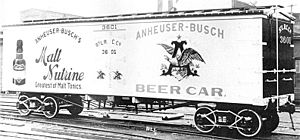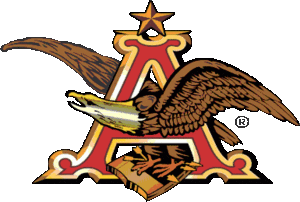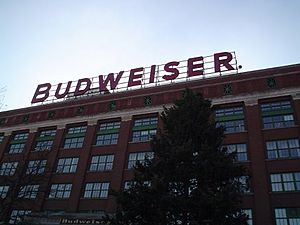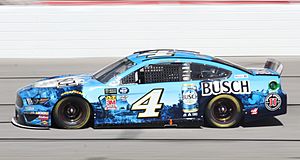Anheuser-Busch facts for kids
 |
|
| Subsidiary | |
| Industry |
|
| Founded | 1852 (as Bavarian Brewery) St. Louis, Missouri, United States |
| Founder | |
| Headquarters |
St. Louis, Missouri
,
U.S.
|
|
Number of locations
|
12 Breweries & 9 Can Plants |
|
Area served
|
North America |
|
Key people
|
|
| Products | |
| Revenue | US$15.588 billion (2018) |
| US$9.811 billion (2018) | |
| Parent | AB InBev |
Anheuser-Busch Companies, LLC is a famous American company that makes drinks. Its main office is in St. Louis, Missouri. Since 2008, it has been owned by a larger company called AB InBev. AB InBev is now the biggest drink-making company in the world. It owns many well-known brands like Budweiser, Michelob, and Stella Artois.
Anheuser-Busch has over 19,000 employees. It runs 12 places where drinks are made and 9 factories that make aluminum cans in the United States. Until 2009, it also owned and ran ten theme parks, including the SeaWorld parks.
Contents
History of Anheuser-Busch
How the Company Started and Grew
In 1852, a German-American brewer named George Schneider opened a brewery in St. Louis, Missouri. It was first called the Bavarian Brewery. After a few years, the brewery faced money problems. In 1860, it was bought by William D'Oench and Eberhard Anheuser. Anheuser was a successful soap maker.
Adolphus Busch came to St. Louis from Germany in 1857. He married Eberhard Anheuser's daughter, Lilly, in 1861. After serving in the American Civil War, Busch started working at the Anheuser Brewery. In 1869, he bought D'Oench's share of the company. He then became a key leader in the business.
Adolphus Busch was very innovative. He was the first American brewer to use pasteurization to keep drinks fresh. He also used mechanical refrigeration and special refrigerated train cars. He started using these train cars in 1876 to ship drinks. By 1877, the company had 40 refrigerated train cars.
Busch was also one of the first to bottle drinks widely. Being able to ship bottled drinks across the country helped the company grow a lot. This led to more demand for Anheuser products. The company expanded its facilities in St. Louis during the 1870s. Production grew from 31,500 barrels in 1875 to over 200,000 in 1881.
To help with shipping, Busch started the St. Louis Refrigerator Car Company in 1878. This company built and leased refrigerated cars. By 1888, it owned 850 cars. Anheuser-Busch also started its own railway company in 1887.
In the 1870s, Adolphus Busch traveled in Europe. He learned about new ways of making drinks, especially a popular type called pilsner. In 1876, Busch used the name Budweiser for his new drink. This name was already known from a city in Europe. His company's ability to ship bottled drinks made US Budweiser the first national drink brand in the United States. It was sold as a "premium" (high-quality) drink.
The company changed its name to Anheuser-Busch Brewing Association in 1879. In 1880, Adolphus Busch became the company president. The Busch family owned and controlled the company for many generations.
In the 1880s and 1890s, Busch created many advertisements and giveaways. These included bottle openers, calendars, and postcards. One very famous giveaway was a print of a painting called Custer's Last Fight. Busch gave out thousands of these prints to bars in 1896. This was the same year Anheuser-Busch introduced its new "super-premium" brand, Michelob. Over a million copies of the print were made.
At the start of the 1900s, Anheuser-Busch kept expanding. By 1907, it made almost 1.6 million barrels of drinks. As more people wanted to ban alcohol in the United States, Anheuser-Busch started making non-alcoholic drinks. The most successful of these was Bevo, a malt drink introduced in 1908. After Adolphus Busch died in 1913, his son, August Anheuser Busch Sr., took over. He continued to fight against the ban on alcohol.
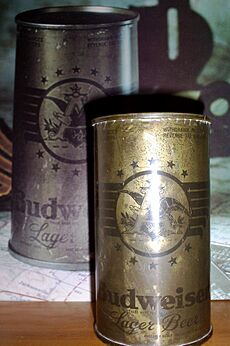
The Prohibition Years
The Prohibition in the United States was a time from the 1910s to the 1930s when alcohol was illegal. This was a very hard time for all breweries. To survive, Anheuser-Busch sold other products. These included baker's yeast, malt extract, ice cream, and Bevo. Bevo was a non-alcoholic malt drink, sometimes called "near beer."
After Prohibition to the Sale of the Company
In 1957, Anheuser-Busch became the largest drink maker in the United States.
In 1981, Anheuser-Busch International, Inc. was created. This part of the company handled its business in other countries. Before it was bought in 2008, Anheuser-Busch had 15 breweries outside the U.S. Most of these were in China.
In 1997, Anheuser-Busch started making products in China. It bought a local brewery there. Later, it also owned the Harbin Brewery. In the United Kingdom, Budweiser was made at the Stag Brewery.
Being Bought by InBev
On June 12, 2008, a company from Belgium and Brazil called InBev offered to buy Anheuser-Busch. The offer was for $46 billion. If the deal happened, it would combine two of the world's biggest drink companies. This would create a company that made three of the most popular drinks: Bud Light, Budweiser, and Skol. InBev said they would not close any U.S. breweries.
At first, Anheuser-Busch said no to the offer. But on July 13, 2008, Anheuser-Busch and InBev agreed to a deal. InBev would buy Anheuser-Busch for $70 per share, which was about $52 billion in total. The new company would be called Anheuser-Busch InBev. This deal created the world's largest drink company. It brought together the makers of Budweiser and Michelob with the makers of Beck's, Stella Artois, and other brands.
On October 7, 2009, the new parent company, Anheuser-Busch InBev, announced plans to sell the theme parks division. This division included the SeaWorld parks. It was sold to The Blackstone Group for up to $2.7 billion.
Changes After the Sale
On November 18, 2008, the sale was completed. Anheuser-Busch became a company fully owned by the new Anheuser-Busch InBev (AB InBev). After the sale, AB InBev focused on cutting costs. They wanted to make the company more profitable.
They made many changes. They let go of some employees and sold some company assets. For example, they sold the theme parks. They also changed some benefits for employees. These changes helped AB InBev reduce its debt.
In February 2013, there was a lawsuit that said AB InBev was "watering down" products like Budweiser. However, this lawsuit was later dismissed. It's common for drinks to be brewed stronger and then mixed with water to reach the right strength and quality.
How Anheuser-Busch Works and What It Makes
Anheuser-Busch Companies is one of several companies that are part of Anheuser-Busch InBev (AB InBev). It makes and sells many of AB InBev's products.
On October 10, 2016, AB InBev and SABMiller, another large drink company, merged. This created an even bigger company.
Company Leaders
Michel Doukeris is the current CEO (Chief Executive Officer) of AB InBev, the main parent company. Brendan Whitworth is the current CEO of the Anheuser-Busch company in the U.S.
Many leaders have guided Anheuser-Busch over the years, including members of the Busch family.
| Years | CEO of parent company AB InBev | Leader of the Anheuser-Busch subsidiary |
|---|---|---|
| 2008–2012 | Carlos Brito | President Dave Peacock |
| 2012–2014 | Luiz Edmond | |
| 2014–2018 | João Castro Neves | |
| 2018–2021 | Michel Doukeris | |
| 2021–Present | Michel Doukeris | CEO Brendan Whitworth |
Places Where Drinks Are Made
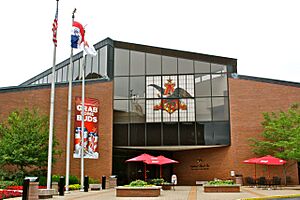
Anheuser-Busch Companies has operated 13 breweries in the United States:
- St. Louis, Missouri (opened 1852)
- Newark, New Jersey (opened 1951)
- Los Angeles, California (opened 1954)
- Tampa, Florida (opened 1959, now closed)
- Houston, Texas (opened 1966)
- Columbus, Ohio (opened 1968)
- Jacksonville, Florida (opened 1969)
- Merrimack, New Hampshire (opened 1970)
- Williamsburg, Virginia (opened 1972)
- Fairfield, California (opened 1976)
- Baldwinsville, New York (opened 1983)
- Fort Collins, Colorado (opened 1988)
- Cartersville, Georgia (opened 1993)
The St. Louis brewery opened in 1852. It is a very old and important place, recognized as a National Historic Landmark District. You can take public tours of this brewery. On the tour, you can see how drinks are made and packaged. The company also keeps some of its famous Budweiser Clydesdales horses at its headquarters. Visitors can see these beautiful horses in their exercise field and their special carriage house.
The St. Louis brewery was named a National Historic Landmark in 1966. It has many old buildings, including the Brew House built in 1891–1892. This building is known for its fancy details and iron-work.
Other Parts of the Company
Besides making drinks, Anheuser-Busch Companies also has other businesses. It has divisions that handle wholesale operations and agricultural operations. It also owns factories that make aluminum cans (Metal Container Corporation). These factories supply cans to Anheuser-Busch breweries and other companies.
Anheuser-Busch delivers its products to stores through a network of over 500 independent distributors.
For many years, Anheuser-Busch owned the St. Louis Cardinals Major League Baseball team. They bought the team in 1953 and owned them until 1996. In 1966, the company also paid for and built Busch Memorial Stadium for the baseball team. They later bought the stadium in 1981. The old stadium was torn down in 2005. A new ballpark was built in 2006, and Anheuser-Busch agreed to keep the "Busch Stadium" name on it.
Until 2009, Anheuser-Busch was also one of the biggest owners of theme parks in the United States. This included the three SeaWorld locations. The theme park company is now called SeaWorld Parks & Entertainment.
Drinks Made by Anheuser-Busch
Anheuser-Busch Companies makes, imports, and sells many AB InBev products. These include three of the company's main global brands: Budweiser, Stella Artois, and Beck's. Other well-known brands made or sold by Anheuser-Busch Companies include Bud Light, Busch Beer, Michelob, Michelob Ultra, and Natural Light. The company also makes non-alcoholic drinks and flavored malt drinks.
In 2015, Anheuser-Busch announced it would buy Breckenridge Brewery.
Advertising and Marketing
Before it was bought by InBev, Anheuser-Busch was famous for its advertising in the United States. It had a special sports marketing team. This team created ads for the Super Bowl and many other sports events. Budweiser has sponsored horse racing and motorsports like NASCAR.
After AB InBev bought the company, they reduced how much they spent on advertising. They believed that people's habits were changing, so they didn't need to spend as much on big sports events.
Connections with Washington University in St. Louis
Adolphus Busch joined the Board of Directors at Washington University in St. Louis in 1895. He stayed on the board until he died in 1913. His son, August Anheuser Busch Sr., then took his place. Even though other family members didn't join the board, the company and the university stayed connected.
August Busch III, who was CEO of Anheuser-Busch from 1975 to 2002, also became a trustee of the university. The Anheuser-Busch Foundation even donated money for a building named Anheuser-Busch Hall. This was to honor Fred L. Kuhlmann, who worked for both the company and the St. Louis Cardinals.
Even though the Busch family no longer owns Anheuser-Busch, the connection with the university continues. Jack H. Purnell, a former CEO of Anheuser-Busch, now works at the university's business school.
See Also
- Anheuser-Busch InBev
- Anheuser-Busch Brewing Association Building
- SeaWorld Entertainment
- Manufacturers Railway (St. Louis)
- Jacques Chirac – former President of France worked at the St Louis plant in the 1950s during his summer term at Harvard University.


